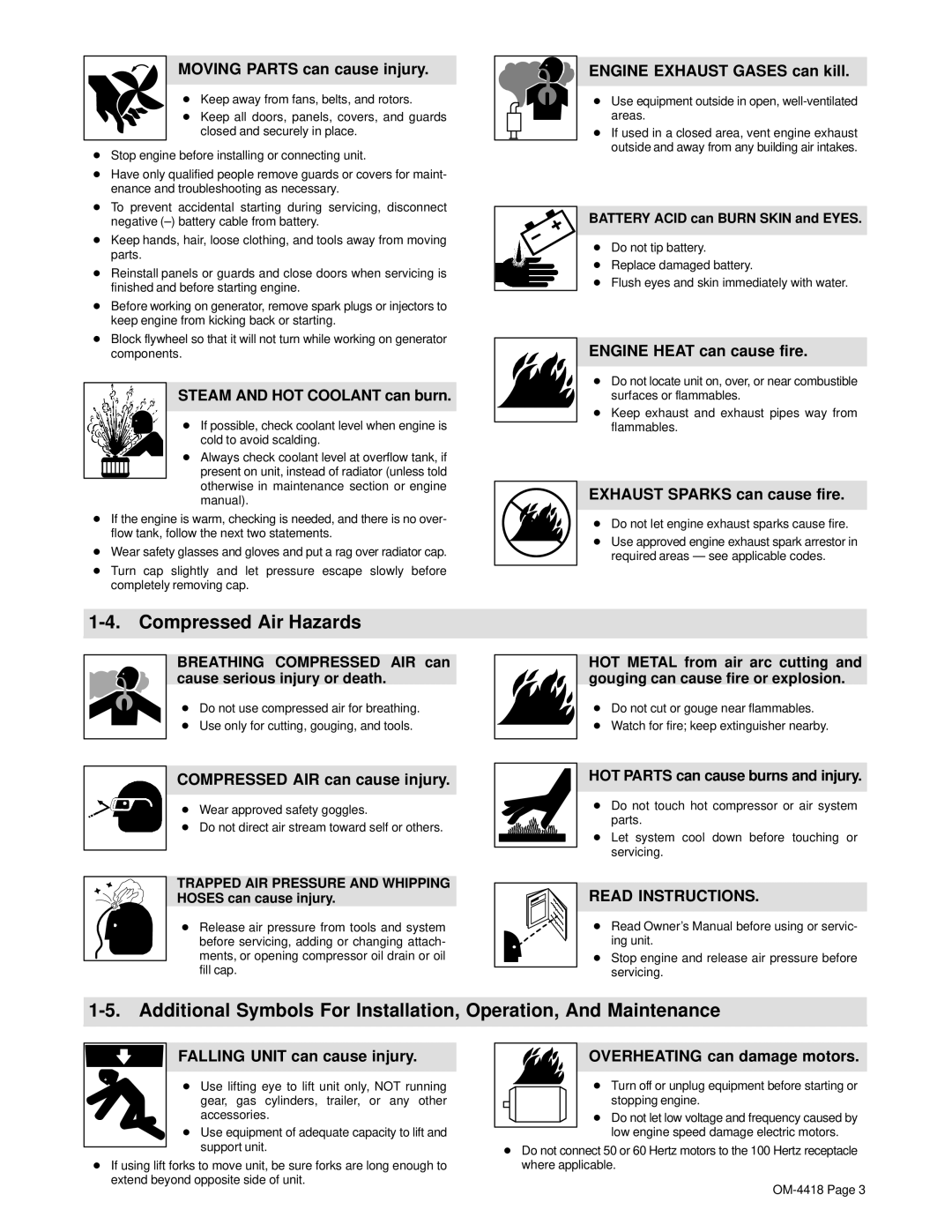
MOVING PARTS can cause injury.
D Keep away from fans, belts, and rotors.
D Keep all doors, panels, covers, and guards closed and securely in place.
DStop engine before installing or connecting unit.
DHave only qualified people remove guards or covers for maint- enance and troubleshooting as necessary.
DTo prevent accidental starting during servicing, disconnect negative
DKeep hands, hair, loose clothing, and tools away from moving parts.
DReinstall panels or guards and close doors when servicing is finished and before starting engine.
DBefore working on generator, remove spark plugs or injectors to keep engine from kicking back or starting.
DBlock flywheel so that it will not turn while working on generator components.
STEAM AND HOT COOLANT can burn.
DIf possible, check coolant level when engine is cold to avoid scalding.
D Always check coolant level at overflow tank, if present on unit, instead of radiator (unless told otherwise in maintenance section or engine manual).
DIf the engine is warm, checking is needed, and there is no over- flow tank, follow the next two statements.
DWear safety glasses and gloves and put a rag over radiator cap.
DTurn cap slightly and let pressure escape slowly before completely removing cap.
ENGINE EXHAUST GASES can kill.
DUse equipment outside in open, well-ventilated areas.
DIf used in a closed area, vent engine exhaust outside and away from any building air intakes.
BATTERY ACID can BURN SKIN and EYES.
DDo not tip battery.
DReplace damaged battery.
DFlush eyes and skin immediately with water.
ENGINE HEAT can cause fire.
DDo not locate unit on, over, or near combustible surfaces or flammables.
DKeep exhaust and exhaust pipes way from flammables.
EXHAUST SPARKS can cause fire.
DDo not let engine exhaust sparks cause fire.
DUse approved engine exhaust spark arrestor in required areas — see applicable codes.
1-4. Compressed Air Hazards
BREATHING COMPRESSED AIR can cause serious injury or death.
DDo not use compressed air for breathing.
DUse only for cutting, gouging, and tools.
HOT METAL from air arc cutting and gouging can cause fire or explosion.
DDo not cut or gouge near flammables.
DWatch for fire; keep extinguisher nearby.
COMPRESSED AIR can cause injury.
DWear approved safety goggles.
DDo not direct air stream toward self or others.
TRAPPED AIR PRESSURE AND WHIPPING HOSES can cause injury.
DRelease air pressure from tools and system before servicing, adding or changing attach- ments, or opening compressor oil drain or oil fill cap.
HOT PARTS can cause burns and injury.
DDo not touch hot compressor or air system parts.
DLet system cool down before touching or servicing.
READ INSTRUCTIONS.
DRead Owner’s Manual before using or servic- ing unit.
DStop engine and release air pressure before servicing.
FALLING UNIT can cause injury.
DUse lifting eye to lift unit only, NOT running gear, gas cylinders, trailer, or any other accessories.
DUse equipment of adequate capacity to lift and support unit.
DIf using lift forks to move unit, be sure forks are long enough to extend beyond opposite side of unit.
OVERHEATING can damage motors.
DTurn off or unplug equipment before starting or stopping engine.
DDo not let low voltage and frequency caused by low engine speed damage electric motors.
DDo not connect 50 or 60 Hertz motors to the 100 Hertz receptacle where applicable.
